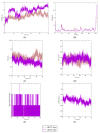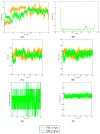In Silico Evaluation of Iranian Medicinal Plant Phytoconstituents as Inhibitors against Main Protease and the Receptor-Binding Domain of SARS-CoV-2
- PMID: 34577194
- PMCID: PMC8470205
- DOI: 10.3390/molecules26185724
In Silico Evaluation of Iranian Medicinal Plant Phytoconstituents as Inhibitors against Main Protease and the Receptor-Binding Domain of SARS-CoV-2
Abstract
The novel coronavirus disease 2019 (COVID-19) is caused by the severe acute respiratory syndrome coronavirus 2 (SARS-CoV-2), which initially appeared in Wuhan, China, in December 2019. Elderly individuals and those with comorbid conditions may be more vulnerable to this disease. Consequently, several research laboratories continue to focus on developing drugs to treat this infection because this disease has developed into a global pandemic with an extremely limited number of specific treatments available. Natural herbal remedies have long been used to treat illnesses in a variety of cultures. Modern medicine has achieved success due to the effectiveness of traditional medicines, which are derived from medicinal plants. The objective of this study was to determine whether components of natural origin from Iranian medicinal plants have an antiviral effect that can prevent humans from this coronavirus infection using the most reliable molecular docking method; in our case, we focused on the main protease (Mpro) and a receptor-binding domain (RBD). The results of molecular docking showed that among 169 molecules of natural origin from common Iranian medicinal plants, 20 molecules (chelidimerine, rutin, fumariline, catechin gallate, adlumidine, astragalin, somniferine, etc.) can be proposed as inhibitors against this coronavirus based on the binding free energy and type of interactions between these molecules and the studied proteins. Moreover, a molecular dynamics simulation study revealed that the chelidimerine-Mpro and somniferine-RBD complexes were stable for up to 50 ns below 0.5 nm. Our results provide valuable insights into this mechanism, which sheds light on future structure-based designs of high-potency inhibitors for SARS-CoV-2.
Keywords: chelidimerine; coronavirus; inhibitor; main protease; medicinal plant; molecular docking; molecular dynamics simulation; receptor-binding domain.
Conflict of interest statement
The authors declare no conflict of interest.
Figures




Similar articles
-
Targeting COVID-19 (SARS-CoV-2) main protease through active phytochemicals of ayurvedic medicinal plants - Withania somnifera (Ashwagandha), Tinospora cordifolia (Giloy) and Ocimum sanctum (Tulsi) - a molecular docking study.J Biomol Struct Dyn. 2022 Jan;40(1):190-203. doi: 10.1080/07391102.2020.1810778. Epub 2020 Aug 27. J Biomol Struct Dyn. 2022. PMID: 32851919 Free PMC article.
-
In Silico Identification of Potential Natural Product Inhibitors of Human Proteases Key to SARS-CoV-2 Infection.Molecules. 2020 Aug 22;25(17):3822. doi: 10.3390/molecules25173822. Molecules. 2020. PMID: 32842606 Free PMC article.
-
Moroccan Medicinal plants as inhibitors against SARS-CoV-2 main protease: Computational investigations.J Biomol Struct Dyn. 2021 May;39(8):2971-2979. doi: 10.1080/07391102.2020.1758790. Epub 2020 May 6. J Biomol Struct Dyn. 2021. PMID: 32306860 Free PMC article.
-
An Updated Review on SARS-CoV-2 Main Proteinase (MPro): Protein Structure and Small-Molecule Inhibitors.Curr Top Med Chem. 2021;21(6):442-460. doi: 10.2174/1568026620666201207095117. Curr Top Med Chem. 2021. PMID: 33292134 Review.
-
A critical review on phytochemicals as antiviral medications for SARS-CoV-2 virus infection.Naunyn Schmiedebergs Arch Pharmacol. 2025 Mar;398(3):2053-2069. doi: 10.1007/s00210-024-03467-z. Epub 2024 Oct 1. Naunyn Schmiedebergs Arch Pharmacol. 2025. PMID: 39352534 Review.
Cited by
-
In Silico Identification of a Potential TNF-Alpha Binder Using a Structural Similarity: A Potential Drug Repurposing Approach to the Management of Alzheimer's Disease.Biomed Res Int. 2024 Jan 6;2024:9985719. doi: 10.1155/2024/9985719. eCollection 2024. Biomed Res Int. 2024. PMID: 38221912 Free PMC article.
-
Network Pharmacology- and Molecular Dynamics Simulation-Based Bioprospection of Aspalathus linearis for Type-2 Diabetes Care.Metabolites. 2022 Oct 24;12(11):1013. doi: 10.3390/metabo12111013. Metabolites. 2022. PMID: 36355096 Free PMC article.
-
A flavone from the ethyl acetate extract of Leea rubra leaves with DNA damage protection and antineoplastic activity.Biochem Biophys Rep. 2022 Mar 14;30:101244. doi: 10.1016/j.bbrep.2022.101244. eCollection 2022 Jul. Biochem Biophys Rep. 2022. PMID: 35308071 Free PMC article.
-
Plant-derived compounds effectively inhibit the main protease of SARS-CoV-2: An in silico approach.PLoS One. 2022 Aug 23;17(8):e0273341. doi: 10.1371/journal.pone.0273341. eCollection 2022. PLoS One. 2022. PMID: 35998194 Free PMC article.
-
Integrative in silico and in vivo Drosophila model studies reveal the anti-inflammatory, antioxidant, and anticancer properties of red radish microgreen extract.Sci Rep. 2025 May 27;15(1):18533. doi: 10.1038/s41598-025-02999-5. Sci Rep. 2025. PMID: 40425671 Free PMC article.
References
-
- Ayerdi O., Puerta T., Clavo P., Vera M., Ballesteros J., Fuentes M.E., Estrada V., Rodríguez C., Del Romero J. Preventive Efficacy of Tenofovir/Emtricitabine Against Severe Acute Respiratory Syndrome Coronavirus 2 Among Pre-Exposure Prophylaxis Users. Open Forum Infect. Dis. 2020;7:ofaa455. doi: 10.1093/ofid/ofaa455. - DOI - PMC - PubMed
-
- Huang H., Gong X. A Review of Protein Inter-residue Distance Prediction. Curr. Bioinform. 2020;15:821–830. doi: 10.2174/1574893615999200425230056. - DOI
MeSH terms
Substances
LinkOut - more resources
Full Text Sources
Miscellaneous

